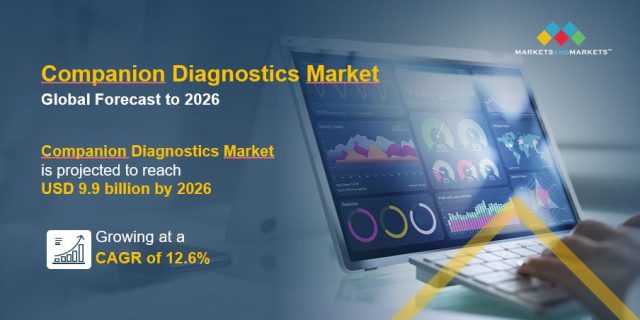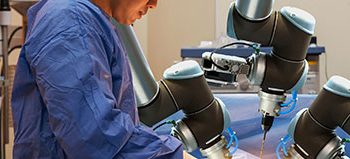
In recent years, the field of medicine has witnessed a transformative shift towards personalized treatments. At the forefront of this movement is the companion diagnostics market, which plays a pivotal role in tailoring medical interventions to individual patients. This article explores the dynamics, significance, and frequently asked questions about companion diagnostics.
The report “Companion Diagnostics Market by Product (Assays, Kits, Software & Services), Technology (PCR, NGS, ISH, IHC), Indication (Breast, Blood, Lung, Colorectal Cancer, Neurology Diseases), End User (Pharma Companies, CROs), Region – Global Forecast to 2026″, the global companion diagnostics market is projected to reach USD 9.9 billion by 2026 from USD 5.5 billion in 2021, at a CAGR of 12.6%.
The policy programs to provide effective care to patients with cancer, high drug development activity, structured regulatory framework in the region, and large patient pool undergoing advanced medical testing. Emerging economies such as China, Japan, and India are providing lucrative opportunities for the players operating in the companion diagnostics market.
Download a PDF Copy: https://www.marketsandmarkets.com/pdfdownloadNew.asp?id=155571681
The major players operating in this market are F. Hoffmann-La Roche Ltd. (Switzerland), Agilent Technologies, Inc. (US), Qiagen N.V. (Germany), Thermo Fisher Scientific, Inc. (US), Abbott Laboratories, Inc. (US), Almac Group (UK), Danaher Corporation (US), Illumina Inc. (US), bioMérieux SA (France), Myriad Genetics, Inc. (US), Sysmex Corporation (Japan), Abnova Corporation (Taiwan), Guardant Health, Inc. (US), ICON Plc (Ireland), BioGenex Laboratories, Inc. (US), Invivoscribe Technologies (US), ArcherDX, Inc. (US), NG Biotech (France), Q² Solutions (US), Amoy Diagnostics Co., Ltd. (China), Abacus Diagnostica Oy (Finland), Asuragen Inc. (US), SAGA Diagnostics (Sweden), Meso Scale Diagnostics, LLC. (US), and Creative Biolabs (US).
The assays, kits & reagents segment accounted for the largest share of the companion diagnostics market, by product & service segment, in 2020
The companion diagnostics market is segmented into assays, kits & reagents, and software & services. The assays, kits & reagents accounted for the largest share of the companion diagnostics market in 2020, mainly due to the availability of a wide range of products, and increasing use of assays and kits in different therapeutic areas.
PCR segment to register the highest growth rate during the forecast period
The companion diagnostics market is segmented into polymerase chain reaction (PCR), next-generation sequencing (NGS), in situ hybridization (ISH), immunohistochemistry (IHC), and other technologies. In 2020, the PCR segment accounted for the largest share of the companion diagnostics market. Factors such as the ease of use and widespread availability of PCR kits & reagents in companion diagnostic testing, and growing applications of PCR in the high-throughput detection of mutants with a limited or low allele frequency of genes.
Cancer segment to register the highest growth rate during the forecast period
The companion diagnostics market is segmented into cancer, cardiovascular diseases (CVDs), neurological diseases, infectious diseases, and other indications (inflammatory and inherited diseases, among others). In 2020, the cancer segment accounted for the largest share of the companion diagnostics market. Factors such as growing role of companion diagnostics in the personalized medicine treatment for cancer and increasing utility of biomarkers in the diagnosis of cancer.
The pharmaceutical & biotechnology companies segment accounted for the largest share of the companion diagnostics market, by end user segment, in 2020
Based on end user, the companion diagnostics market is segmented into pharmaceutical & biotechnology companies, reference laboratories, CROs, and other end users (including physician & hospital laboratories, and academic medical centers). In 2020, pharmaceutical & biotechnology companies accounted for a larger share of the companion diagnostics market. The growing use of companion diagnostics owing to their increasing prominence in drug development, and the increasing importance of companion diagnostic biomarkers.
North America is the largest regional market for companion diagnostics market
The global companion diagnostics market is segmented into five major regions—North America, Europe, the Asia Pacific, Latin America, and the Middle East & Africa. In 2020, North America accounted for the largest share of the companion diagnostics market. The North American companion diagnostics market growth can be attributed to the presence of many leading companion diagnostics vendors & national clinical laboratories, the easy accessibility to technologically advanced devices and instruments, and the highly developed healthcare system in the US and Canada.
Request a Sample Copy: https://www.marketsandmarkets.com/requestsampleNew.asp?id=155571681
Understanding Companion Diagnostics: A Brief Overview
Companion diagnostics are medical tests that aid healthcare professionals in making informed decisions about the most suitable treatments for patients. These tests are specifically designed to identify biomarkers, genetic mutations, or other molecular characteristics that are closely associated with a particular medical condition. The information gleaned from companion diagnostics allows physicians to predict how a patient is likely to respond to a specific treatment, helping to guide therapeutic choices and avoid unnecessary interventions.
Key Drivers of the Companion Diagnostics Market
Personalized Medicine Revolution: The increasing realization that each patient’s genetic makeup influences treatment responses has propelled the demand for companion diagnostics. Pharmaceutical companies are now focusing on developing drugs that are effective for specific patient subsets, and companion diagnostics enable the identification of these subsets.
Improved Treatment Outcomes: By tailoring treatments to an individual’s unique genetic profile, companion diagnostics can lead to more effective outcomes. This approach minimizes trial-and-error prescribing and reduces adverse effects.
Regulatory Support: Regulatory agencies, such as the U.S. Food and Drug Administration (FDA) and the European Medicines Agency (EMA), have recognized the importance of companion diagnostics in guiding precision medicine. They now require comprehensive diagnostic data before approving certain targeted therapies.
Rise in Chronic Diseases: The global prevalence of chronic diseases, including cancer and cardiovascular conditions, has surged. Companion diagnostics enable early detection and personalized treatment plans for these diseases.
Frequently Asked Questions (FAQs) about Companion Diagnostics:
Q1: How do companion diagnostics differ from traditional diagnostics?
A1: Traditional diagnostics focus on identifying the presence or absence of a disease. Companion diagnostics go beyond this by identifying specific molecular markers that indicate the likelihood of a patient responding positively to a particular treatment.
Q2: What are some examples of companion diagnostics in practice?
A2: One notable example is the HER2/neu gene testing for breast cancer patients. This test helps determine whether a patient is a suitable candidate for targeted therapies like trastuzumab (Herceptin).
Q3: Are companion diagnostics limited to cancer treatments?
A3: While companion diagnostics have gained significant traction in oncology, their applications extend to other therapeutic areas like cardiovascular diseases, infectious diseases, and neurological disorders.
Q4: How is patient data privacy maintained in companion diagnostics?
A4: Patient data privacy is a critical concern. Medical data collected for companion diagnostics are subject to strict privacy regulations, such as the Health Insurance Portability and Accountability Act (HIPAA) in the U.S. and the General Data Protection Regulation (GDPR) in the EU.
Q5: Are companion diagnostics cost-effective?
A5: Initially, companion diagnostics may seem costlier due to their specialized nature. However, in the long run, they can reduce healthcare expenses by minimizing ineffective treatments and adverse events.
Q6: What does the future hold for companion diagnostics?
A6: The companion diagnostics market is poised for growth as personalized medicine becomes more prevalent. Technological advancements, increased collaborations between pharmaceutical and diagnostic companies, and expanded regulatory support are expected to shape the future of this field.
In conclusion, companion diagnostics have emerged as a critical component of personalized medicine, revolutionizing how healthcare providers approach treatment decisions. As the field continues to evolve, patients can look forward to more targeted and effective therapies, resulting in improved outcomes and better quality of life.


